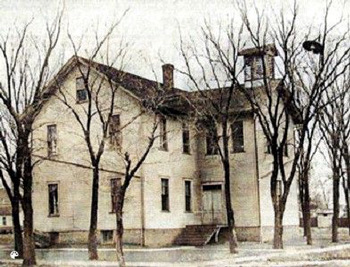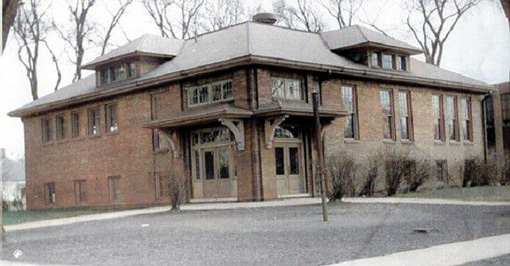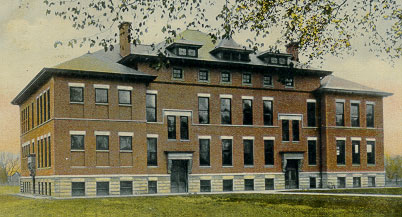The following article was written by Jari Lynn Oncken of Minonk and is reprinted
here with her permission. The text was typed by Donna Rae Eilts.
At this time of year many students look forward to the starting of another school year and former students remember their school days at summer class reunions. Students who attended school in the 1800s surely did not have all the advantages we have today, but they managed quite well.
The history of Minonk schools began in 1856 when the first school was organized in a building that had been used as a boarding house for railroad employees. This building was located on railroad property west of the Webber house that preceded the Woodford Hotel. The Illinois Central railroad had been completed in 1854. In 1857 the first schoolhouse was erected and was also used as a place of worship for several denominations. Township elections, debating clubs and lectures were also held in this building.

The first West Side School was located in the 500 block of Johnson Street
The present west side grade school in Minonk is the third one at that location. The first was a two story frame building erected in the late 1860s. Needing more space, one of the classes met in the "Old German Church" by the park. Many former students remember the second school that was made of brick with three rooms and a basement play area. This school was demolished after the new one was built in 1937.
In the first year book, "The Caldron," that was published by the senior class of 1917, it stated that the old school on the east side, located on the site of the present high school, was a green two story frame building. It was built in 1864 and stood near the street with two entrances to the north with board walks.
The boundary between these two school districts was Oak Street. One principal headed both schools. A former student of the west side school said she did not know kids on the east side of town until she was in the sixth grade that was located, at that time, in the east school building.
It is interesting to note in the 1890s there were only two teachers in the high (school) room. Two courses were taught: the scientific, which included chemistry, geometry, botany, zoology and those studies that were later combined under the heading of physics and some English; and the classical, which included foreign languages, advanced English and history in detail.

The West Side Elementary School, the second grade school, is shown here. The present grade school can be seen to the right of the building.
In 1902 a new east side school was built to accommodate the east side grade school and all high school students. It was made of gray pressed brick with light Bedford stone trimming and asbestos roofing. This school preceded the present high school. The main entrances were on the west side entrances on the north and south. At that time, the school board members were: Thomas Kennedy, J. A. Simpson, Tom Pickard, P. M. Evans, C. M. Golden and Conrad Kohl.
Students who attended this school did so until December 12, 1936, when a fire of undetermined origin was discovered at 5:30 a.m. When the fire was first reported the blaze was on the first floor pouring from the two center windows. It was impossible to save the school so efforts were made to protect the new gymnasium, which still stands. The flames spread rapidly upward and burst through the roof which caved into the basement. Books, equipment and other contents were burnt. The "Little Brown Jug," a trophy passed between the Minonk and Wenona schools; had been won by Wenona that year or that, too, would have been destroyed. Soon after the roof fell, the center portion of the west wall crumbled followed by the center of the east wall. The walls of both wings were left standing.
In 1937 construction was begun on the present grade and high schools. For the first time the new school on the east side would house only the high school students and be known as Minonk Community High School. The first day of school was December 1, 1938. When asked what the difference between the old and new schools was, a former student said, "It was like you died and went to heaven."

Minonk's East Side School, housed students for school year 1902-03, burned down in 1936.
One hundred eighty-nine students were enrolled in MCHS that year and the first graduating class was the class of 1939.
The high school in Minonk has undergone many name changes. In the fall of 1949 Dana students were consolidated and MCHS became Minonk-Dana High School. Rutland students first attended in the fall of 1955 and the high school's name was Minonk-Dana-Rutland High School. The present Fieldcrest Community Unit School District No. 6 includes Minonk-Dana-Rutland No. 108, Toluca No. 2 and Wenona No 1. This merger went into effect on March 17, 1992.
These schools mentioned were not the only Minonk schools. In 1881 St. Patrick's congregation erected a building that housed both its parochial school and sisters' residence. The present church was built in 1892. At the north of the lot was the old church that had been moved from the west side in 1880. This old building was remodeled and became the second school. The present school building was built in 1905. On the first floor were four classrooms each having two classes taught by Catholic sisters. The top floor, which was one big auditorium with a stage, was used for school programs, basketball games and community events. St. Patrick's School closed at the end of the school year in 1971.
There are still many former students in Minonk and Minonk Township who are not represented by the aforementioned schools. Those who live in town can only wonder what it was like to attend a country school. These schools had only one room with one teacher who taught all eight grades. Students usually walked to school, took their lunches, listened to other classes recite, tried to warm in the winter and used outhouses.
Minonk Township had seven country schools. Two miles east of the Minonk Township Cemetery corner was the site of the Beal School and two miles east of that was the East Grant School. Two miles south of the Grant school stood the Spires School, which was converted into a house. The center school was located two miles west of the Spires School. Three miles south of Minonk on Rte. 251 the Woodford School was also remodeled into a residence. Two miles east of that was the Hawthorne School. The Maple Grove School forlornly stands two miles farther east.
It is great to remember our school days, which were not only made up of subjects learned but of lasting friendships and teachers who made a difference. Our lives have been enriched by the years we spent in those classrooms of days gone by.